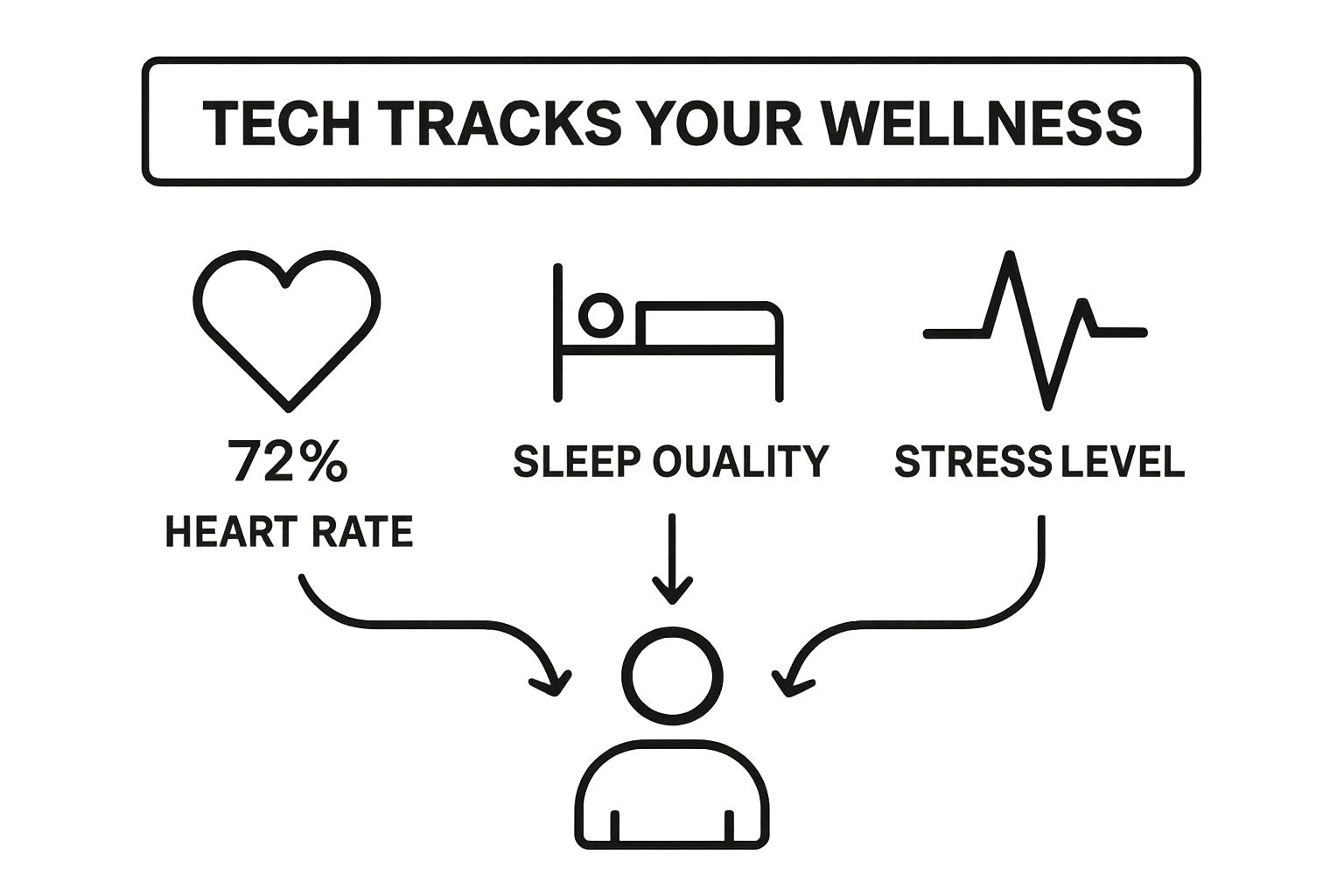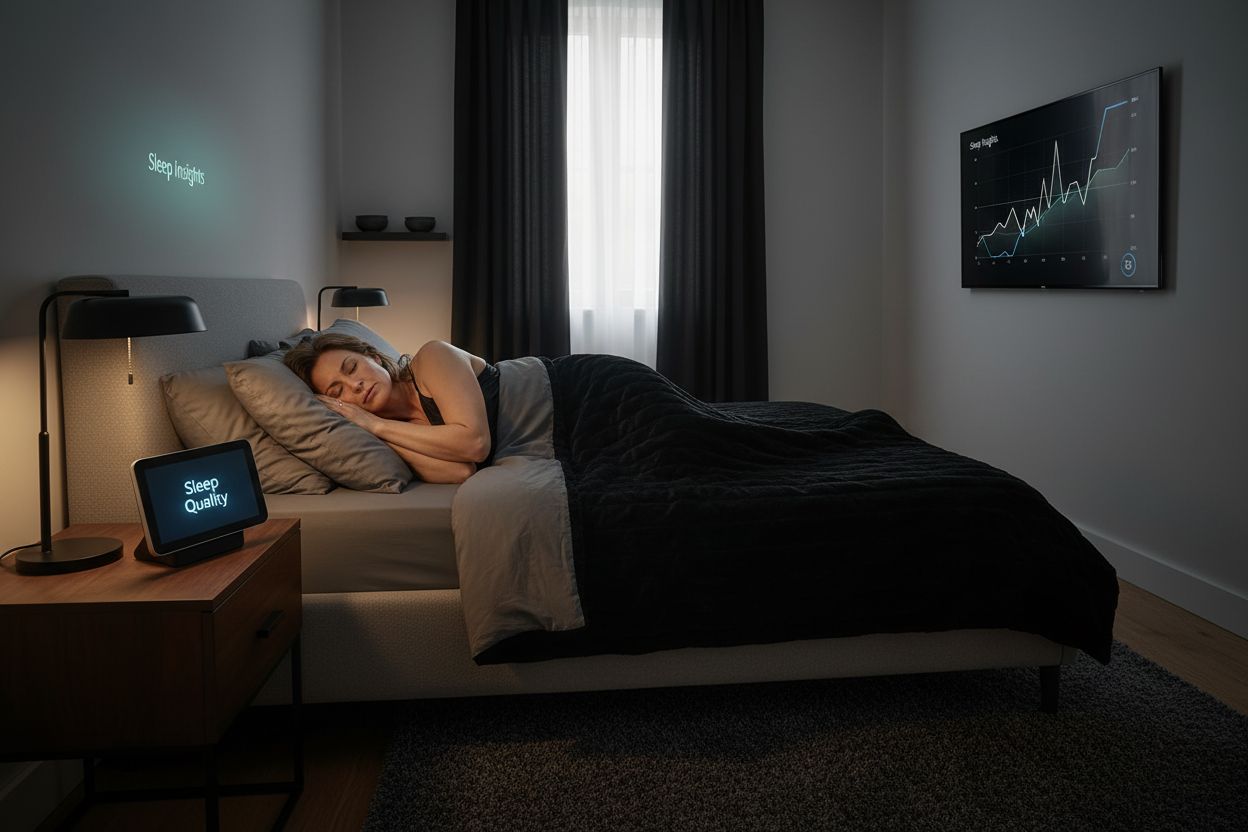Tech is changing wellness in ways that no one saw coming. People are no longer guessing about their health or relying only on checkups. Now, real-time digital tools let them see exactly what is happening in their bodies every day and make smarter choices. Did you know Canadians are using digital health technology at rates that have nearly doubled since 2015 and that’s just the beginning. Most folks expect wearables to be all about counting steps or tracking sleep. The surprise is these devices now use artificial intelligence to spot early health risks and even predict illness before you feel a thing.
Table of Contents
- What Is The Role Of Tech In Wellness?
- Why Technology Matters For Health And Fitness
- How Health Monitoring Tech Works
- Key Concepts In Tech-Enhanced Wellness
- Real-World Applications Of Wellness Technology
Quick Summary
| Takeaway | Explanation |
|---|---|
| Tech enhances personal health management. | Technology transforms wellness into an active journey, empowering individuals to monitor and improve their health. |
| Wearable tech tracks vital health metrics. | Devices like smartwatches measure activity, sleep, and stress, providing real-time health insights for informed decision-making. |
| AI offers personalized wellness recommendations. | Advanced algorithms analyze individual data to create tailored health plans, adapting to users’ evolving needs. |
| Remote monitoring enables proactive healthcare. | Digital health tools allow continuous tracking and provide immediate insights, especially beneficial for managing chronic conditions. |
| Customized fitness plans reduce injury risks. | Machine learning-generated workouts consider personal health data to create safe, effective fitness routines for optimal results. |
What is the Role of Tech in Wellness?
Technology has transformed wellness from a passive concept into an active, personalized experience that empowers individuals to take control of their health journey. The role of tech in wellness is multifaceted, integrating digital tools, data analytics, and innovative solutions that provide comprehensive insights into personal health and lifestyle management.
Understanding Technology’s Health Impact
Wellness technology bridges the gap between traditional healthcare and proactive self-management. According to Statistics Canada, digital health technologies are revolutionizing how Canadians monitor, track, and improve their overall well-being. These advanced systems collect real-time data about physical activity, sleep patterns, nutrition, and physiological metrics, enabling users to make informed decisions about their health.
To give readers a clear understanding of the main technological tools used in wellness, the following table summarizes their core functions and benefits.
| Technology Type | Core Function | Key Benefit |
|---|---|---|
| Wearable Health Monitors | Track vital metrics (heart rate, stress, etc.) | Deliver real-time health insights |
| Mobile Health Applications | Track nutrition, fitness, and habits | Personalized wellness recommendations |
| Remote Health Monitoring | Continuous medical supervision | Enables proactive healthcare for chronic conditions |
| Machine Learning Algorithms | Analyze health data for recommendations | Create safe, customized health and fitness plans |
| Predictive Wellness Systems | Forecast potential health risks | Allow early intervention and preventive strategies |
Key technological wellness innovations include:
- Wearable Health Monitors: Devices tracking heart rate, stress levels, and activity
- Mobile Health Applications: Personalized nutrition and fitness tracking platforms
- Remote Health Monitoring Systems: Enabling continuous medical supervision
Personalized Wellness Through Digital Solutions
Modern wellness technology goes beyond simple tracking. These intelligent systems use artificial intelligence and machine learning algorithms to provide personalized recommendations tailored to individual health profiles. By analyzing comprehensive data points, technology can predict potential health risks, suggest lifestyle modifications, and create customized wellness plans that adapt to changing personal health conditions.
For adults over 40, technology offers unprecedented opportunities to maintain health proactively. Sophisticated algorithms can now interpret complex health data, helping users understand their body’s unique responses to diet, exercise, and stress. This personalized approach transforms wellness from a one-size-fits-all model to a highly individualized health management strategy.
This table provides a quick comparison of key concepts in modern wellness technology to help distinguish their unique contributions.
| Key Concept | Definition | Primary Purpose |
|---|---|---|
| Holistic Health Tracking | Integration of multiple health data streams into unified profiles | Provide a complete view of overall well-being |
| Predictive Wellness Tech | Use of AI to identify health risks before symptoms appear | Enable preventative and proactive health management |
| Data-Driven Health Insights | Application of analytics to physiological data | Support precise and effective fitness strategies |
| Personalized Fitness Plans | AI-generated, individual-specific workout routines | Optimize results and minimize injury risk |
Why Technology Matters for Health and Fitness
Technology has become an essential catalyst in transforming how individuals approach their health and fitness goals. Beyond mere convenience, technological solutions provide sophisticated tools that enable more precise, personalized, and effective wellness strategies for adults seeking comprehensive health management.
Data-Driven Health Insights
Modern fitness technology turns complex physiological data into actionable intelligence. Harvard Medical School highlights that digital health tools provide unprecedented transparency into personal wellness metrics. These advanced systems analyze multiple health parameters simultaneously, offering insights that were previously accessible only through extensive medical testing.
Critical data tracking capabilities include:
- Precise metabolic rate calculations
- Cardiovascular performance monitoring
- Stress response and recovery tracking
- Detailed sleep quality analysis
Personalized Fitness Optimization
Technology enables highly customized fitness experiences that adapt to individual physiological characteristics. Machine learning algorithms can now generate exercise recommendations that account for age, fitness level, past injuries, and specific health goals. This approach moves beyond generic workout plans, creating targeted strategies that maximize effectiveness while minimizing injury risks.
For adults over 40, these personalized technologies are particularly transformative. Sophisticated fitness platforms can design low-impact workout routines that maintain muscle strength, improve flexibility, and support joint health. By understanding an individual’s unique physical profile, technology helps create sustainable fitness strategies that evolve with changing bodily needs.
How Health Monitoring Tech Works
Health monitoring technology represents a sophisticated intersection of advanced sensors, data analytics, and intelligent interpretation systems that transform raw physiological information into meaningful wellness insights. By capturing intricate biological signals, these technologies provide users with comprehensive understanding of their body’s current state and potential health trajectories.
Sensor Technologies and Data Collection
Modern health monitoring devices leverage multiple advanced sensors to capture precise physiological data. Statistics Canada highlights how accelerometers and biosensors embedded in wearable devices track physical activity and critical health metrics. These miniature technological marvels can detect subtle changes in movement, heart rate, body temperature, and oxygen levels with remarkable accuracy.
Key sensor technologies include:
- Photoplethysmography (PPG) Sensors: Measuring heart rate and blood oxygen levels
- Electrodermal Activity Sensors: Tracking stress and emotional responses
- Triaxial Accelerometers: Monitoring movement patterns and physical activity
Intelligent Data Processing and Interpretation
Beyond raw data collection, health monitoring technologies employ advanced machine learning algorithms to transform complex physiological signals into actionable wellness insights. These intelligent systems analyze historical data, compare current readings against established health baselines, and generate personalized recommendations that adapt to an individual’s changing health profile.
For adults over 40, this technological approach offers unprecedented health management capabilities.
By continuously monitoring subtle physiological changes, these systems can detect early warning signs of potential health issues, enabling proactive intervention and more informed healthcare decisions. The integration of artificial intelligence allows for nuanced interpretation that goes far beyond simple metric tracking, providing a comprehensive view of an individual’s overall wellness trajectory.
Key Concepts in Tech-Enhanced Wellness
Tech-enhanced wellness represents a paradigm shift in how individuals understand, monitor, and improve their health. This emerging field integrates cutting-edge technological innovations with holistic approaches to personal well-being, creating comprehensive strategies that empower users to take proactive control of their health journey.
Holistic Health Tracking
Modern wellness technologies transcend traditional health monitoring by providing integrated health ecosystem approaches. Canadian Institute for Health Information emphasizes that comprehensive health tracking now combines multiple physiological and lifestyle metrics into unified health profiles. These advanced systems analyze interconnected data points, revealing complex relationships between physical activity, nutrition, sleep, stress levels, and overall wellness.
Core integrated tracking dimensions include:

- Physiological performance metrics
- Nutritional intake and metabolic responses
- Psychological and emotional well-being indicators
- Environmental health influences
Predictive Wellness Technologies
Predictive wellness technologies utilize sophisticated machine learning algorithms to forecast potential health trajectories. By analyzing comprehensive historical and real-time health data, these intelligent systems can identify subtle patterns and potential risk factors before they manifest as significant health challenges. This proactive approach transforms healthcare from a reactive model to a preventative strategy.
For adults over 40, predictive wellness technologies offer unprecedented insights into personal health management. These advanced systems can generate personalized recommendations that adapt to individual physiological changes, helping users make informed decisions about diet, exercise, stress management, and preventative care. The integration of artificial intelligence enables a dynamic, responsive approach to wellness that evolves with an individual’s changing health needs.
Real-World Applications of Wellness Technology
Wellness technology has transcended theoretical concepts, emerging as a practical toolkit that transforms how individuals manage their health across multiple life domains. These innovative solutions provide tangible, actionable strategies that enable proactive personal health management with unprecedented precision and personalization.
Healthcare Management and Remote Monitoring
Canadian Medical Association highlights the critical role of digital health technologies in revolutionizing patient care. Remote monitoring systems now allow continuous health tracking, enabling healthcare professionals to receive real-time physiological data without traditional in-person consultations. This approach is particularly beneficial for adults managing chronic conditions, offering immediate insights and early intervention opportunities.
Key remote health monitoring applications include:
- Continuous cardiac performance tracking
- Blood glucose level monitoring for diabetes management
- Medication adherence and dosage tracking
- Post-surgical recovery progress assessment
Personalized Fitness and Lifestyle Optimization
Wellness technologies have transformed fitness from generic exercise routines to highly customized, intelligent health optimization strategies. Advanced platforms now generate workout plans that adapt dynamically to an individual’s changing physical condition, fitness goals, and physiological responses. Machine learning algorithms analyze workout performance, recovery rates, and biomechanical data to create progressively personalized fitness experiences.
For adults over 40, these technologies offer nuanced approaches to maintaining physical health. By understanding individual limitations and strengths, wellness tech can design low-impact exercise regimens that support muscle maintenance, joint health, and metabolic efficiency. The result is a more sustainable, intelligent approach to fitness that respects individual physiological constraints while promoting continuous improvement.

Bring Wellness Technology Into Your Everyday Life
You want results that actually fit your lifestyle. If you’re reading about health monitoring, wearables, and personalized wellness, chances are you’re ready to try the digital tools that make real change possible—especially as you move past 40, when proactive care is so important. The article highlighted how personalized data, smart fitness tech, and holistic health tracking help adults take charge of their own well-being. But it can be hard to find high-quality products designed for your needs in one convenient place. That’s exactly where we come in.

Ready to take control of your wellness journey? Visit Real Healthy Haven for curated health monitors, fitness gear, supplements, and more—each chosen to make tech-driven wellness simple and accessible. Don’t wait to put the latest solutions into action. Explore our full selection or take the next step toward healthy aging by joining the community that puts your needs first.
Frequently Asked Questions
What are the benefits of using wearable health monitors?
Wearable health monitors provide real-time tracking of vital metrics such as heart rate, physical activity, and stress levels. This helps individuals make proactive health decisions and maintain their well-being more effectively.
How does personalized wellness technology adapt to individual health needs?
Personalized wellness technology uses artificial intelligence and machine learning to analyze user data and offer tailored recommendations for diet, exercise, and lifestyle changes based on unique health profiles.
What role does data-driven health insight play in fitness management?
Data-driven health insights help users understand their physiological performance by providing detailed analytics on metrics like metabolic rate, cardiovascular health, and recovery patterns, resulting in more effective fitness strategies.
How do predictive wellness technologies enhance health outcomes for individuals over 40?
Predictive wellness technologies analyze historical and real-time data to identify potential health risks early, allowing users to take preventive measures and make informed choices about their health as they age.
